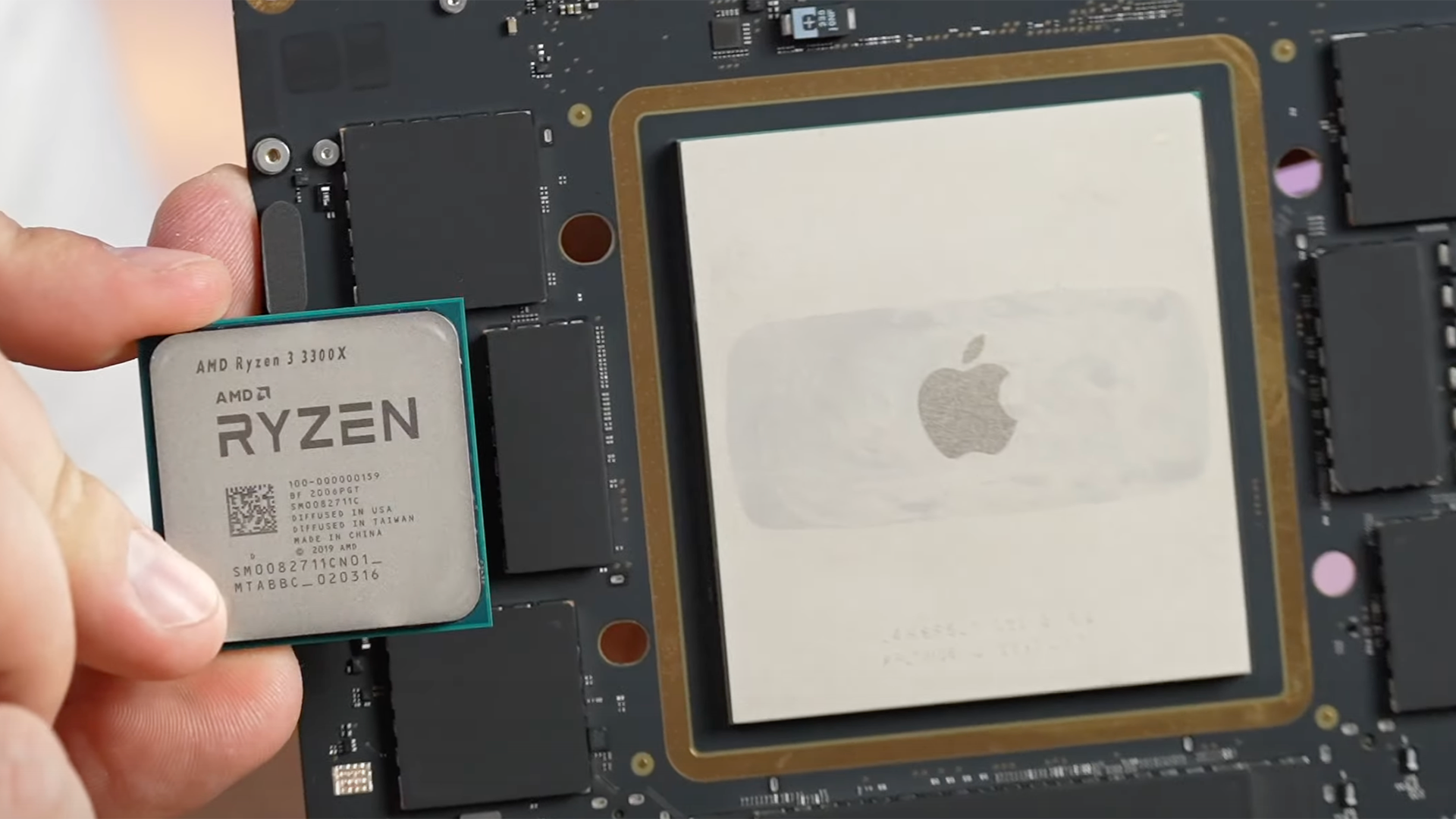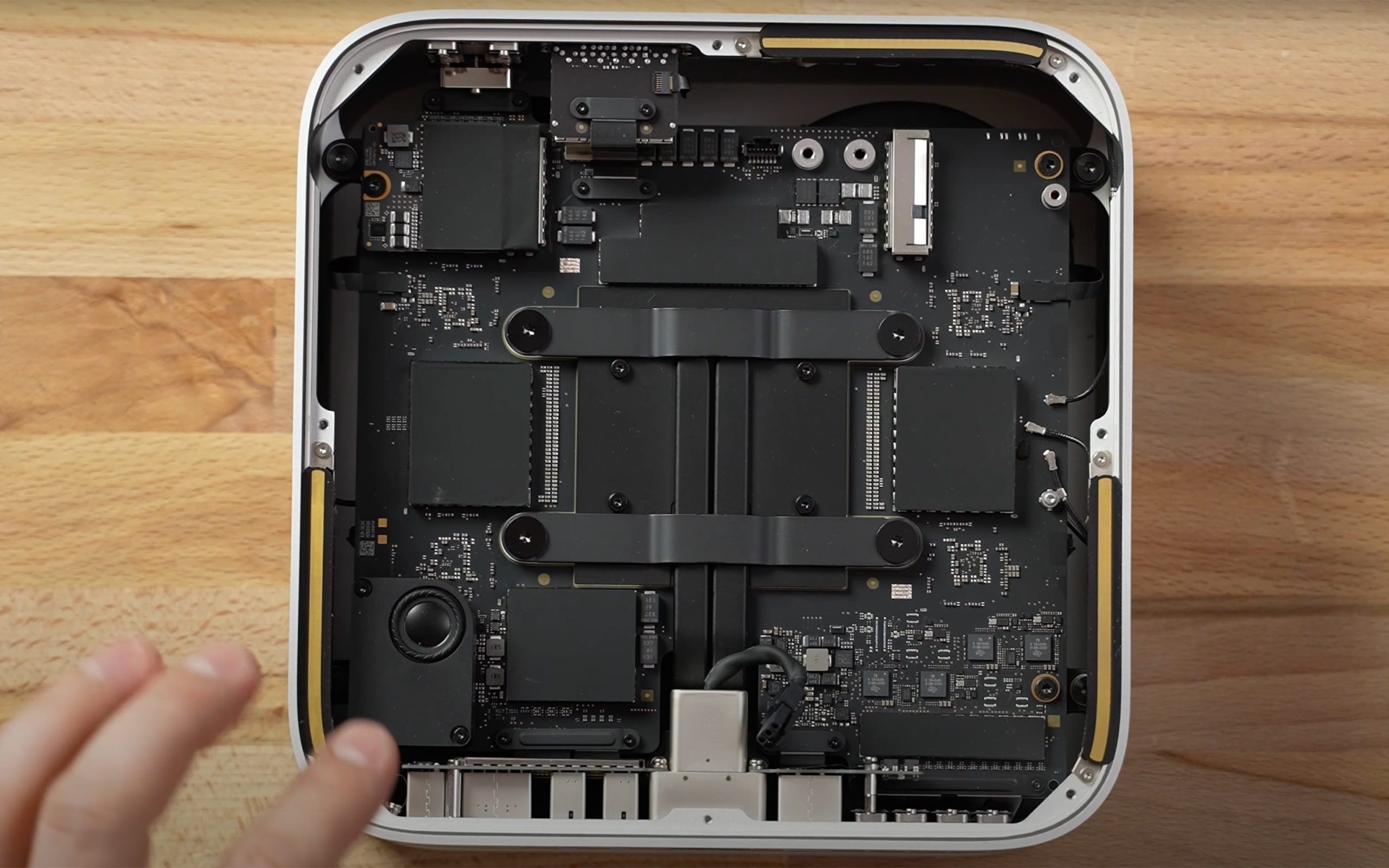Mac Studio Dissected: M1 Ultra About 3x Bigger Than AMD's Ryzen CPUs
Mac Studio packs massive M1 Ultra and uses modular SSDs that is user-accessible.
The Mac Studio features a minimalistic design that looks pretty humble compared to modern workstations like other Apple devices. But what these design hides are Apple's massive M1 Ultra processor package that occupies around one-fourth of the motherboard, a very complex voltage regulating module (VRM), and two user-accessible SSDs.
Now that Apple is shipping Mac Studio systems to the end-user, some of the latter dissect these PCs to find out their internal design and architecture. Indeed, there is a lot to look at with the Mac Studio. Apple's Mac Studio is a masterpiece of high-precision engineering that comprises hundreds of components installed on a relatively small printed circuit board, as revealed by the Max Tech YouTube channel, which was the first to teardown a Mac Studio.
Apple M1 Ultra: Three Times Bigger than Ryzen
Apple's M1 Ultra processor is two M1 Max system-on-chips (SoCs) in TSMC's CoWoS-S (chip-on-wafer-on-substrate with silicon interposer) 2.5D interposer-based package. The two SoCs feature memory subsystems. They are linked together using the company's UltraFusion interprocessor interconnection that offers a bandwidth of 2.5 TB/s, enough to present two GPUs and two memory subsystems as one to the OS. We expected Apple's M1 Ultra to be massive given such an architecture.
Indeed, the M1 Ultra is massive. Compared to an AMD Ryzen processor in an AM4 form-factor, it is about three times larger. One M1 Ultra occupies around 25% of Mac Studio's motherboard. Since we are two M1 Maxes, the M1 Ultra has two rather complex VRMs that can feed the two-headed beast and ensure high-quality power to let it run at high clocks. It, of course, means that we are dealing with a very complex motherboard, but if you need to maximize performance, this is the way to go.
Since the M1 Ultra consumes quite a lot of power and generates quite a lot of heat, it is not surprising that it needs a very advanced dual-fan cooling system. The cooling system takes away heat from the top of the processor and its bottom, which gives a pretty good idea about the heat generated by the unit.
But while the M1 Ultra looks large for Apple users, there is an even bigger thing inside the new Mac Studio.
Upgradeable Storage
The vast majority of Apple's PCs released in recent years are known for being utterly non-upgradeable by the end-user, so the end-user did not need to disassemble them. Furthermore, none of the M1-based systems released allows for an upgrade as they feature soldered-down memory and solid-state drives (SSDs). But with Mac Studio, the company decided that change the design bit and use modular SSDs instead of a soldered-down drive. Potentially, this opens doors to upgradeability unless, of course, there are software limitations.
Get Tom's Hardware's best news and in-depth reviews, straight to your inbox.
It is not very hard to open up Apple's Mac Studio: you need to remove the rubber ring from the bottom, unbolt the screws, and detach the base. Once you remove the base, you immediately notice the bottom of the power supply and one or two modular SSDs installed into their slots (if only one is filled, you see a spare SSD slot). The drives use a proprietary form-factor, which is logical as the SSD controller resides in the SoC, and the drives themselves do not need to carry one. The critical thing is that both SSD slots are accessible without removing the PSU.
Officially, Apple claims that the drives are not user upgradeable, so accessing them probably voids the warranty (at least for now), but Apple could enable its authorized partners to offer SSD upgrade services. Or lift the limitation altogether, let hardware suppliers like OWC produce SSDs in an appropriate form factor.
Apple has consistently argued that soldering down NAND chips allows it to make its systems more portable. Still, this argument does not stand because there are more compact systems that use regular modular M.2 drives.
Meanwhile, SSD modules allow PC makers to be more flexible with configurations. Mac Studio, for example, is offered with 512GB (M1 Max only) 1TB, 2TB, 4TB, and 8TB storage options as well as with 32GB/64GB (M1 Max) or 64GB/128GB (M1 Ultra) of memory. Since Mac Studio uses SSD modules, Apple needs to make four motherboards. It would have to produce 10 M1 Max and eight M1 Ultra mainboards with soldered-down storage.
Apple's new SSD modules look pretty small, so perhaps eventually, Apple could use them for other systems too?

Anton Shilov is a contributing writer at Tom’s Hardware. Over the past couple of decades, he has covered everything from CPUs and GPUs to supercomputers and from modern process technologies and latest fab tools to high-tech industry trends.
-
PiranhaTech I agree with the article. There's SSDs that have a very small form factor like the 2242.Reply -
Historical Fidelity There are many grammar errors in this article. “But what these design hides are Apple's massive M1 Ultra processor package”Reply
“some of the latter dissect these PCs to find out their internal design and architecture.”
“Since we are two M1 Maxes”
“But with Mac Studio, the company decided that change the design bit and use modular SSDs”
where is the Tom’s Hardware editor? Pretty much every article I’ve read has some form of grammar error, but this article is particularly guilty. Producing articles free of language error is one of the oldest requirements of journalism. A little bit of quality control would be nice. -
Geef Imagine a Ryzen 7 processor of that size...Reply
Lets see, 512 cores, 256MB L1 cache, 1GB L2 cache, 32GB L3 cache...
There is also a Ryzen X3D series which doubles the cache and lets you overclock 511 cores. It keeps one core at normal to keep the AMD Haters at bay by giving them something to hate on. :ROFLMAO: -
Co BIY The heat spreader is huge but the cooling system doesn't seem to make contact with that much of it based on the shadow that remains.Reply -
hotaru.hino It's a promo shot, but it does show how the package is laid outReply
So the heat sink only needs to make contact with the middle. There's probably some thermal pads or whatnot for the RAM, but they likely don't dissipate enough heat to be a problem. -
Sleepy_Hollowed That is a wild CPU, truly amazing.Reply
Reminds me of Intel's failed IA64 CPUs, that were massive compared to their AMD64 ones, but this is even bigger. Incredible. -
The M1 Ultra may be 3x bigger than a Ryzen CPU, but 2/3 of it is just the RAM, which a Ryzen CPU doesn't have.Reply
-
escksu Its rather inaccurate to say that M1 Ultra is 3x the size of Ryzen. 2/3 of the space in that heat spreader is taken up by 8 RAM modules.Reply
What really incredible about the M1 Ultra is that despite its die size, it uses even less power than the Ryzen (M1 CPU alone is around 60W, Ryzen 105W).
The GPU is even more impressive. No doubt its not as powerful as RTX3090 (nowhere near it). But its pretty close to RTX3070 at a fraction of its power. Now imagine what it could do with Apple decides to add more "cores" increase the power envelope to 200W.. -
escksu ReplyNolonar said:The M1 Ultra may be 3x bigger than a Ryzen CPU, but 2/3 of it is just the RAM, which a Ryzen CPU doesn't have.
Yes, and Ryzen does not have GPU too (unless its the G series). ITs GPU is also way more power than any AMD/Intel equivalent.
So, here we have. A powerful CPU with integrated GPU thats incredibly powerful and yet low power consumption (low compared to Intel/AMD/Nvidia equivalents). -
Historical Fidelity Reply
Most of the additional power that AMD/intel CPU’s use is for the added transistor complexity and transistor real estate needed for backwards compatibility of all of x86’s instructions. X86 processors must be able to utilize seldom used instructions dating all the way back to the 1980’s. That is the #1 difference in power consumption vs ARM. That’s why comparing arm/Apple vs x86 is apples and oranges.escksu said:Yes, and Ryzen does not have GPU too (unless its the G series). ITs GPU is also way more power than any AMD/Intel equivalent.
So, here we have. A powerful CPU with integrated GPU thats incredibly powerful and yet low power consumption (low compared to Intel/AMD/Nvidia equivalents).




